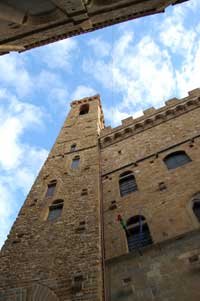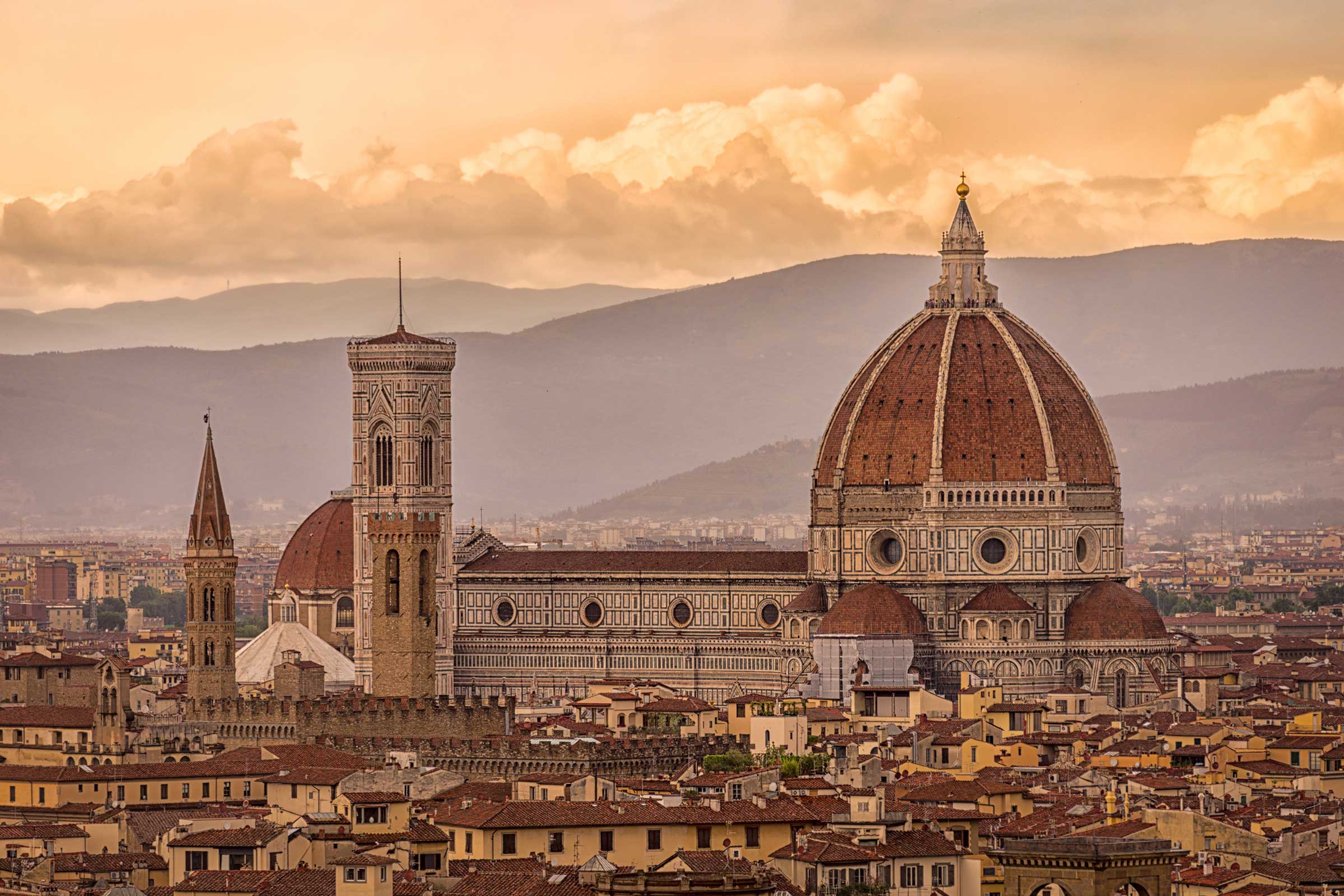History of Florence for tourists who want to learn more ...
 It is believed that in ancient times the area of the Arno Valley, today's Florence, was inhabited by tribes of the Neolithic Ligurian, from northern Italy.
It is believed that in ancient times the area of the Arno Valley, today's Florence, was inhabited by tribes of the Neolithic Ligurian, from northern Italy.
The origins of the Etruscans are still very mysterious, since it is sure that they have been the first settlement near Fiesole intornoall 'IX sec.aC
Around 59 BC, when Caesar became consul in Rome, the same established a garrison for Veterans Arno, calling Florentia (the "flourishing"), whose construction was probably from 30a.C.
Florentia stood near a strategic crossing point of the river and its configuration reflected in all respects the prototypical Roman city.
The first true urban revolution occurred during the reign of Hadrian, the second century, who gave the city a spa and an amphitheater. Under Diocletian, the late third century., Florentia became the capital of Royal Tuscia et Umbria.
Soon, Italy and the Western Roman Empire found themselves face to various barbarian invasions that culminated with the coronation of King Theodoric in 493.
Then the longobaridi took control over most of northern Italy including Florentia.
Middle Ages
Once created the Holy Roman Empire, with the coronation of Charlemagne in 800, Tuscia passed under it and included the present Tuscany, Umbria, Lazio and most of Corsica.
Right under the duchy of Matilda of Canossa Florence boasted about twenty thousand inhabitants and had assumed an important role as regional capital. After the death of the Duchess, the situation worsened with Federico Barbarossa who was willing to bring the city back under royal control.
And 'This is the period of the birth of the first municipalities through which the influential families tried to take power. During this period in Florence there are two factions: the Guelphs and Ghibellines. Early supporters of the pope, the second emperor. The Guelph, mostly consisting of wealthy merchants, demanded greater autonomy than that the Emperor of the Holy Roman Empire was prepared to grant, while the Ghibellines tended noble families to some extent, intended to be part of the imperial power. Around 1250 the Guelphs were now able to penetrate to Siena , Pisa and other Tuscan cities.
The divergence of views but I wear the Guelphs split into two distinct factions: Guelph Guelph blacks and whites. The Guelph blacks, with the help of the Pope, they managed to bully the whites who were later exiled (including these Dante Alighieri ).
Despite the severe plague, as reported by historian and writer Villani, fell on Florence in 1333, the city showed great ability in 'afforntare the situation, so he decided to go to war and the subjugation of San Gimignano, Volterra, Pistoia, Prato and Pisa.
The situation was still the worst and famine, looting, taxes led to a popular revolt in 1378. It ended with a period of uncertain stability in which the Florentines decided to impose the land, the first system of collecting taxes on income.
The rise of the Medici
During the fifteenth century Florence had a great influence on their family of John Bicci Medici. When in 1429, the eldest son Cosimo, became paterfamilias, the Abizi, other known Florentine family, concocted a way to send him into exile.
Eventually, however, was precisely the Abizi to get worse and be expelled from Florence. Cosimo de 'Medici was the guide of Florence for over thirty years of increasing power and prosperity of the city.
Until his death in 1464, the city experienced a rare moment of peace and joined the approximately 70,000 inhabitants. After Cosimo's son Piero took over who had the merit to set some important laws although perhaps more recognized role in history is undoubtedly the grandson of Cosimo, Lorenzo.
The Pazzi family had learned that Lawrence had become a very influential personality in Florence and we had organized a plot against him in which but fell's brother Lawrence, Julian, 26 April 1478 during the mass in the cathedral.
After the ensuing flight, Lawrence founded the Council of Seventy, with powers exceeding those of worship and was recognized by all as Lorenzo the Magnificent.
After his death, only 43 years, power passed to his son Piero and resulted in a very dark period for Florence.
The Republic of Savonarola
Piero de 'Medici expelled after only two years, the republic was restored in 1494 and was again amended the constitution. Were occurring as a climate entirely new, inaugurated by the Dominican friar Girolamo Savonarola. He led the organization according to the Venetian model and established the Council of Five Hundred which served as a parliamentary assembly. But Savonarola problems immediately aroused as he accused the Church of corruption and excesses.
Were times of hunger and famine and the fact that Savonarola continued to profess God's chosen emissary only worsened the situation.
Into disrepute by the Franciscans, the Dominicans rivals, after a series of disagreements, May 22, 1498 Savonarola was hanged and burned at the stake on charges of heresy, in Piazza della Signoria.
Around 1512 the situation sought to be resumed by the But the Medici family which had lost so much influence in Florence. Supporters of Doctors tried to give confidence to Cosimo, the first descendant of Cosimo de 'Medici, who is credited with having built the Uffizi to accommodate all government departments.
After a series of short and ineffective rulers, powers europeeavevano addressed the problem of succession Tuscan "and appointed Francis III, Duke of Lorraine and husband of Empress Maria Theresa of Austria.
The Queen of France and Napoleon
Francis III and Maria Theresa of Austria ', although provedduto somehow improve the situation of Florence, were not seen in other authorities as benevolent accused of systematically depleting the resources of Florence in favor of the Austrian Empire.
With the arrival of Leopold, in 1765, the situation was improved as abolished torture and the death penalty was abolished the Inquisition, began the construction of schools for the poor, urged the municipality of Florence to clean up the city and introduce the system of naming streets.
He was succeeded by his son Ferdinand III, who had to face Napoleon Bonaparte, who appointed his sister, Elisa Baciocchi, Grand Duchess of Tuscany.
After the fall of Napoleon, the Restoration restored Ferdinand III of Tuscany at the helm. In 1824 his death threw the people into despair.
The Unification of Italy
After the turn of figliom Ferdinand was Leopold II, who spurred the insurrection of 1848 was forced to flee to Vienna. His return did nothing to change the destiny of Florence so that 15 March 1860 the Grand Duchy of Florence announced the membership of the Kingdom of Sardinia.
In 1861 it was the unification of Italy, ruled by a constitutional monarchy.
In 1865 King Vittorio Emanuele and the national government moved to Florence in the last five years that was the capital, Florence took over much of its present appearance.
The World Wars
In 1920 the fascist Benito Mussolini had already opened several offices in Florence, October 22 Mussolini marched on Rome and Florence in 2000 Fascists took control of buildings stretegici as the railway station and the headquarters of telecommunications.
For his loyalty to the city were granted a new stadium and the Campo di Marte station Santa Maria Novella, in addition received an honorary visit of Mussolini and Hitler of his German ally.
When he signed the armistice, Italy surrendered to the Germans but Florence had established their headquarters in Piazza San Marco while the SS practicing torture in their local Via Bolognese.
When the Allies approached the German lines near Florence, in 1944 the German high command decided to destroy all the bridges in the city, except the Ponte Vecchio.
At dawn on August 4, the Florentine bridges blown up. The last German troops withdrew from Fiesole September 7.
